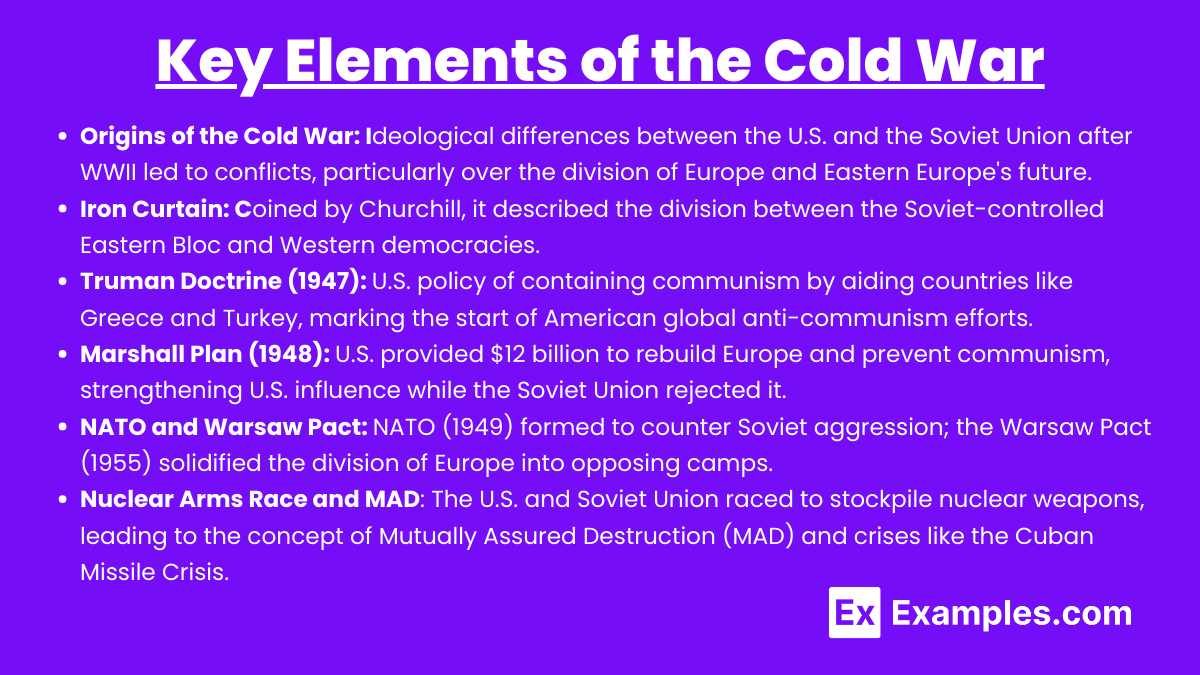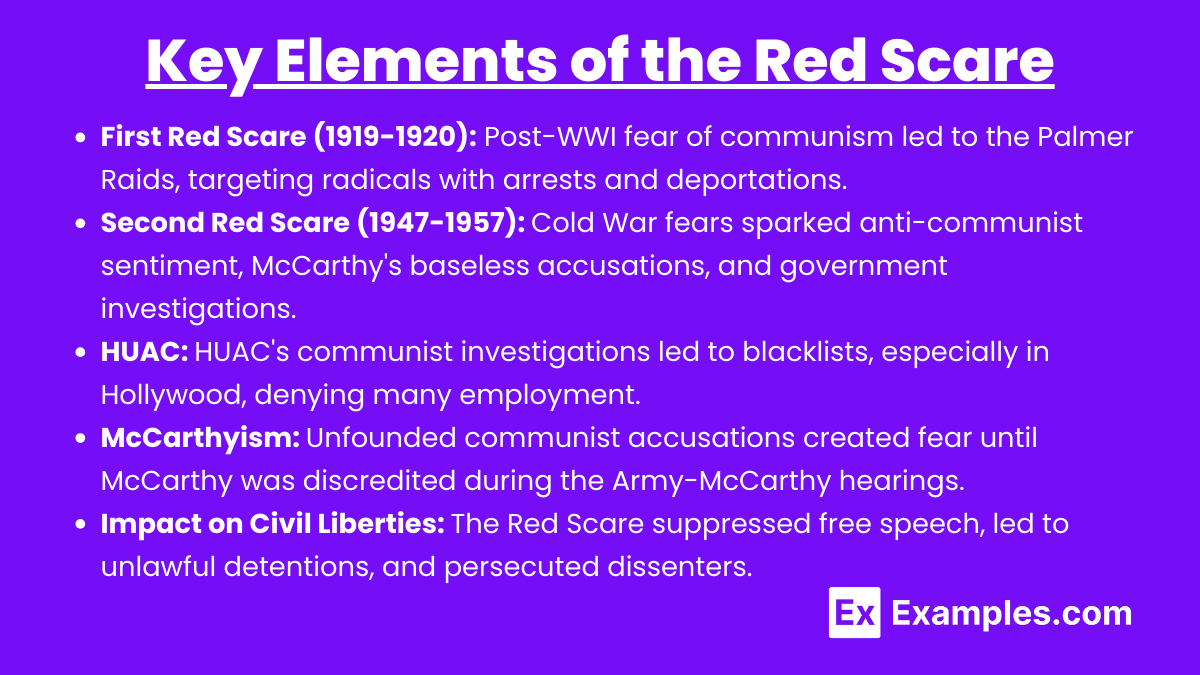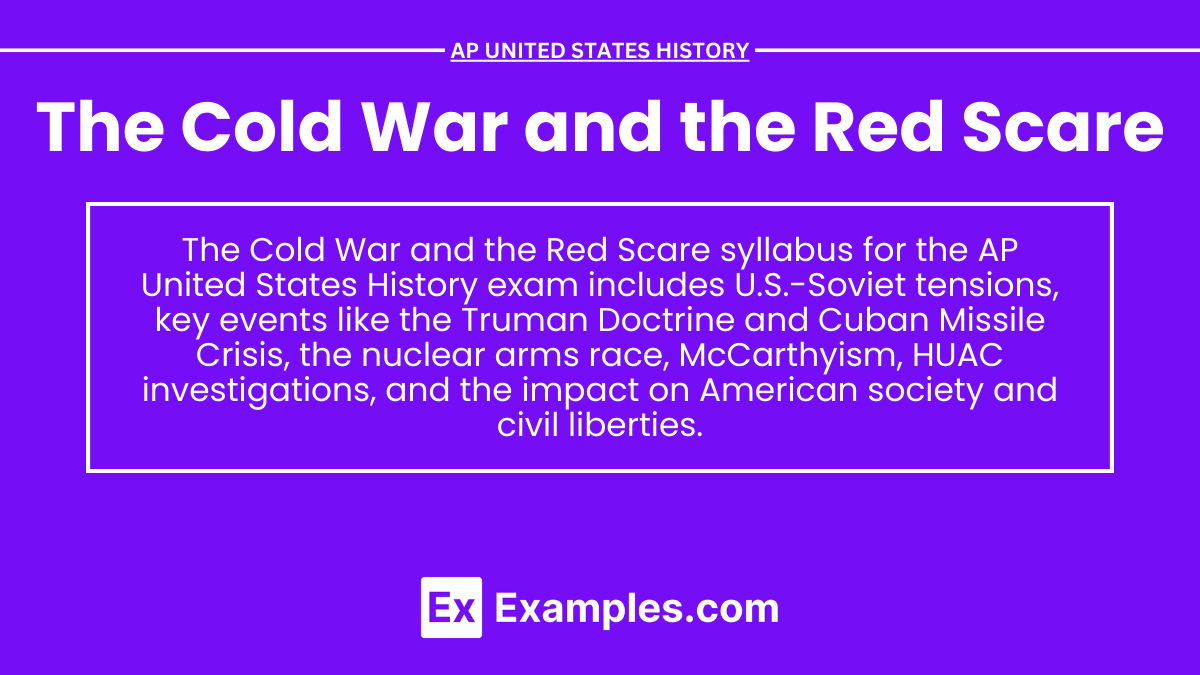In AP United States History, the Cold War and the Red Scare are studied as pivotal periods marked by intense geopolitical tensions between the United States and the Soviet Union, characterized by ideological conflict, nuclear arms races, and global power struggles. Domestically, the Red Scare fueled widespread fear of communist infiltration, leading to government investigations, loyalty tests, and significant violations of civil liberties. These events shaped U.S. foreign and domestic policies and had lasting impacts on American society and global relations.
Learning Objectives
In AP United States History, you will be expected to understand the origins and key events of the Cold War, including the Truman Doctrine, Marshall Plan, and nuclear arms race. The impact of the Red Scare on American society, including McCarthyism and the House Un-American Activities Committee (HUAC), will be analyzed. You will examine how these events shaped U.S. foreign and domestic policies, as well as the effects on civil liberties and the broader global context during this period.
Key Elements of the Cold War

Origins of the Cold War:
- The ideological differences between the capitalist United States and the communist Soviet Union became apparent after World War II. The division of Europe, particularly Germany, and disagreements over Eastern Europe’s future sowed the seeds of conflict.
- The “Iron Curtain,” a term coined by Winston Churchill, described the division between the Soviet-controlled Eastern Bloc and the Western democracies.
Truman Doctrine (1947):
- The Truman Doctrine was the U.S. policy of containing communism by providing economic and military aid to countries threatened by communist takeover, beginning with Greece and Turkey.
- This doctrine marked the start of the U.S.’s global leadership in the fight against communism, laying the groundwork for American involvement in conflicts like the Korean and Vietnam Wars.
Marshall Plan (1948):
- The Marshall Plan was an economic program aimed at rebuilding war-torn Europe, stabilizing economies to prevent the spread of communism. The U.S. provided over $12 billion in aid to Western European nations.
- The plan fostered economic recovery in Europe and strengthened U.S. influence in the region, while the Soviet Union viewed it as a threat and refused participation.
NATO and Warsaw Pact:
- NATO (North Atlantic Treaty Organization) was formed in 1949 as a military alliance between the U.S., Canada, and Western European nations to counter Soviet aggression. It was the first peacetime military alliance in U.S. history.
- In response, the Soviet Union established the Warsaw Pact in 1955, a military alliance with Eastern European satellite states, solidifying the division of Europe into opposing camps.
Nuclear Arms Race and Mutually Assured Destruction (MAD):
- The U.S. and the Soviet Union engaged in a nuclear arms race, rapidly developing and stockpiling nuclear weapons. The concept of Mutually Assured Destruction (MAD) arose, where both superpowers had enough nuclear capability to destroy each other, deterring direct conflict.
- This led to tense moments, such as the Cuban Missile Crisis in 1962, where the world came close to nuclear war.
Key Elements of the Red Scare

First Red Scare (1919-1920):
- The First Red Scare occurred after World War I, driven by fears of Bolshevik revolutionaries following the Russian Revolution of 1917. It led to widespread fear of communism, anarchism, and radical leftism in the U.S.
- The Palmer Raids, led by Attorney General A. Mitchell Palmer, targeted suspected radicals, resulting in arrests and deportations without due process.
Second Red Scare (1947-1957):
- The Second Red Scare was fueled by fears of communist infiltration during the early Cold War. It was marked by anti-communist sentiment, government investigations, and loyalty tests for federal employees.
- Senator Joseph McCarthy became synonymous with the era, leading a series of high-profile investigations and accusing numerous government officials, entertainers, and intellectuals of being communists without substantial evidence.
House Un-American Activities Committee (HUAC):
- HUAC was a congressional committee that investigated alleged communist activities in the U.S. It gained notoriety for its aggressive questioning of suspected communists in government, the entertainment industry, and other sectors.
- HUAC’s actions led to blacklists, where individuals accused of communist sympathies were denied employment, particularly in Hollywood.
McCarthyism:
- McCarthyism refers to the practice of making unsubstantiated accusations of communism or disloyalty, named after Senator McCarthy. It created an atmosphere of fear and repression, with individuals being accused of subversion without proper evidence.
- The era ended when McCarthy’s tactics were publicly discredited during the Army-McCarthy hearings in 1954, leading to his censure by the Senate.
Impact on Civil Liberties:
- The Red Scare led to significant violations of civil liberties, including the suppression of free speech, unlawful detentions, and the persecution of political dissenters. Fear of communism justified government overreach, often at the expense of individual rights.
Examples
Example 1: Truman Doctrine Implementation
The Truman Doctrine’s implementation in Greece and Turkey marked the U.S.’s commitment to containing communism globally, setting the stage for Cold War confrontations.
Example 2: Marshall Plan Success
The Marshall Plan successfully revitalized Western European economies, helping to prevent the spread of communism in the region and solidifying U.S. influence in postwar Europe.
Example 3: Cuban Missile Crisis
The Cuban Missile Crisis was a critical moment in the Cold War, where the U.S. and the Soviet Union came close to nuclear conflict over Soviet missiles in Cuba, eventually resolved through diplomacy.
Example 4: HUAC and Hollywood Blacklist
HUAC’s investigations led to the Hollywood blacklist, where actors, writers, and directors suspected of communist ties were denied work, illustrating the widespread fear and repression of the Red Scare.
Example 5: McCarthy’s Downfall
Senator McCarthy’s influence waned after the Army-McCarthy hearings, where his baseless accusations were exposed, leading to his censure and the decline of McCarthyism.
MCQs
What was the primary goal of the Truman Doctrine?
- A) To rebuild Europe’s economy after World War II
- B) To contain the spread of communism
- C) To promote nuclear disarmament
- D) To establish the United Nations
Explanation: The Truman Doctrine was aimed at containing communism by providing military and economic assistance to countries threatened by communist influence, marking the start of the Cold War.
Which event is most closely associated with McCarthyism?
- A) The Marshall Plan
- B) The Cuban Missile Crisis
- C) The Army-McCarthy hearings
- D) The formation of NATO
Explanation: The Army-McCarthy hearings exposed Senator Joseph McCarthy’s baseless accusations and aggressive tactics, leading to his censure and the decline of McCarthyism.
What was the significance of the Marshall Plan?
- A) It provided military support to Eastern European countries
- B) It initiated the nuclear arms race
- C) It helped rebuild Western European economies to prevent communism
- D) It established NATO as a military alliance
Explanation: The Marshall Plan provided economic aid to Western Europe to rebuild after World War II, with the goal of stabilizing these countries to prevent the spread of communism.


